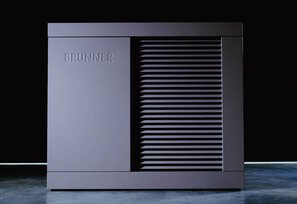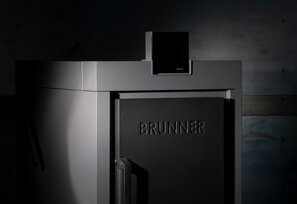Wood moisture measurement
What happens when wood is too damp?
Whoever heats with wood knows: For a proper fire, the logs must be thoroughly dry. But what are the possibilities for measuring the moisture content of wood? What do you have to look out for and when do you even talk about dry wood?
The law stipulates that only wood with a moisture content of less than 25 percent in relation to the dry or kiln-dried weight of the fuel may be burnt in combustion plants. A value of just under 20 percent is called dry wood, and it may also be officially designated as such. Even better, however, is a residual moisture content of 18 to 15 percent, because only then is firewood really dry. Why is this important? Heating errors caused by damp fuel increase emissions many times over. At the same time, the efficiency is reduced. The combustion is incomplete, the glass becomes sooty and wood residues remain. In addition, the glowing time is only short and there can be unpleasant odours outdoors. During combustion, the water or moisture in the wood must first be heated and evaporated. The heat required for this is extracted from the combustion heat, which results in low flame temperatures and smouldering gases.

How can I measure wood moisture?
If you have any doubts as to whether your delivered or self-prepared firewood is actually dry enough, you can check it with a wood moisture meter. It is available in every DIY store and can be used to determine the moisture content of firewood very easily and precisely.
To do this, take a few logs from the wood pile - one alone would not be meaningful, as the wood moisture content can vary within the pile - and split them in the middle. Then the wood moisture meter is placed across the wood fibre and the moisture is determined at two points in the wood core. There are wood moisture meters with insertion probes and those with electrodes on the tip of the device. They are placed on the corresponding spot in the wood.
Methods for measuring wood moisture
Different types of wood have different moisture values, they dry at different rates and each has a different density. This is important to know if you want to buy a measuring device: Commercially available wood moisture meters are adjusted and pre-programmed for the respective type of wood. But which method do you use, the one with plunge probes or electrodes?
- Measuring instruments with plunge probes have the following advantage: They can be retrofitted with probes for a greater depth measurement and for measuring the electrical resistance between the two contact pins. That holes are created in the wood is irrelevant for firewood.
- Wood moisture meters with electrodes work according to the so-called high-frequency measuring principle. This makes it possible to measure the residual moisture both on the surface of the firewood and down to a depth of several centimetres. However, the ambient humidity affects the measurement result and can falsify it.
Measuring wood moisture without a meter
Because you don't always have a wood moisture meter to hand, there are other methods to test how dry the wood actually is, the "soap test" for example.
- Take a log and rub one side a little with washing-up liquid.
- Then blow into the log through the other end.
- Only with dry firewood do white foam bubbles immediately appear on the side with the washing-up liquid. Since there is no more water in the wood fibres and everything has evaporated or dried, you can blow into and through it without any effort.
How do you dry damp wood?
Fresh-cut wood has a moisture content of around 40 to 60 percent and is thus far too wet for heating. How long does wet wood take to dry? If the conditions are not quite ideal, you have to reckon with one to three years. However, if the logs are stored optimally and get plenty of sun and air, even a few months will be enough
Fresh logs are stacked. How high and how big the wood pile is depends on the space available. Dry, roofed and well-ventilated shelters are perfect for storing wood, preferably a sheltered wall. Care should be taken to ensure that no moisture can rise from the ground either. If there is a distance of about ten centimetres to the wall, the air can circulate well, which accelerates the drying of the wood. Inside the stack, the logs are placed in such a way that wind can also pass through. On the ground, thin logs form the base; they are placed crosswise to the direction of storage of the firewood logs to create sufficient distance to the ground. By the way, beech logs have the highest calorific value, followed by maple, cherry, ash.


Conclusion
The right wood moisture is the be-all and end-all for wood heaters. Wood that is too moist does not produce the optimum heating value, emission output increases and the viewing glass gets sooty. Always make sure that you burn dry, well-stored wood. In this way, you are not only doing something for the environment, but also for your wallet.
























